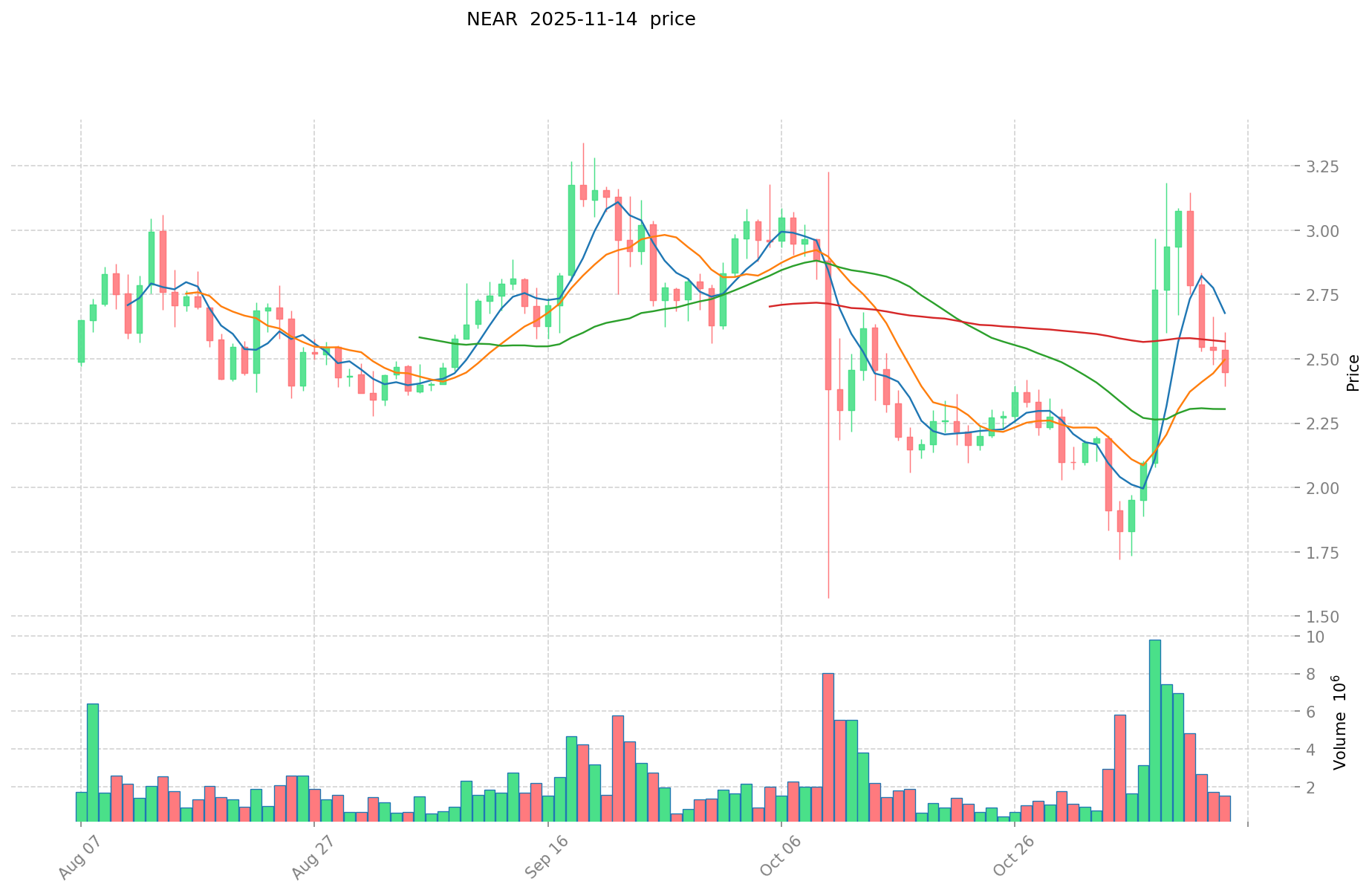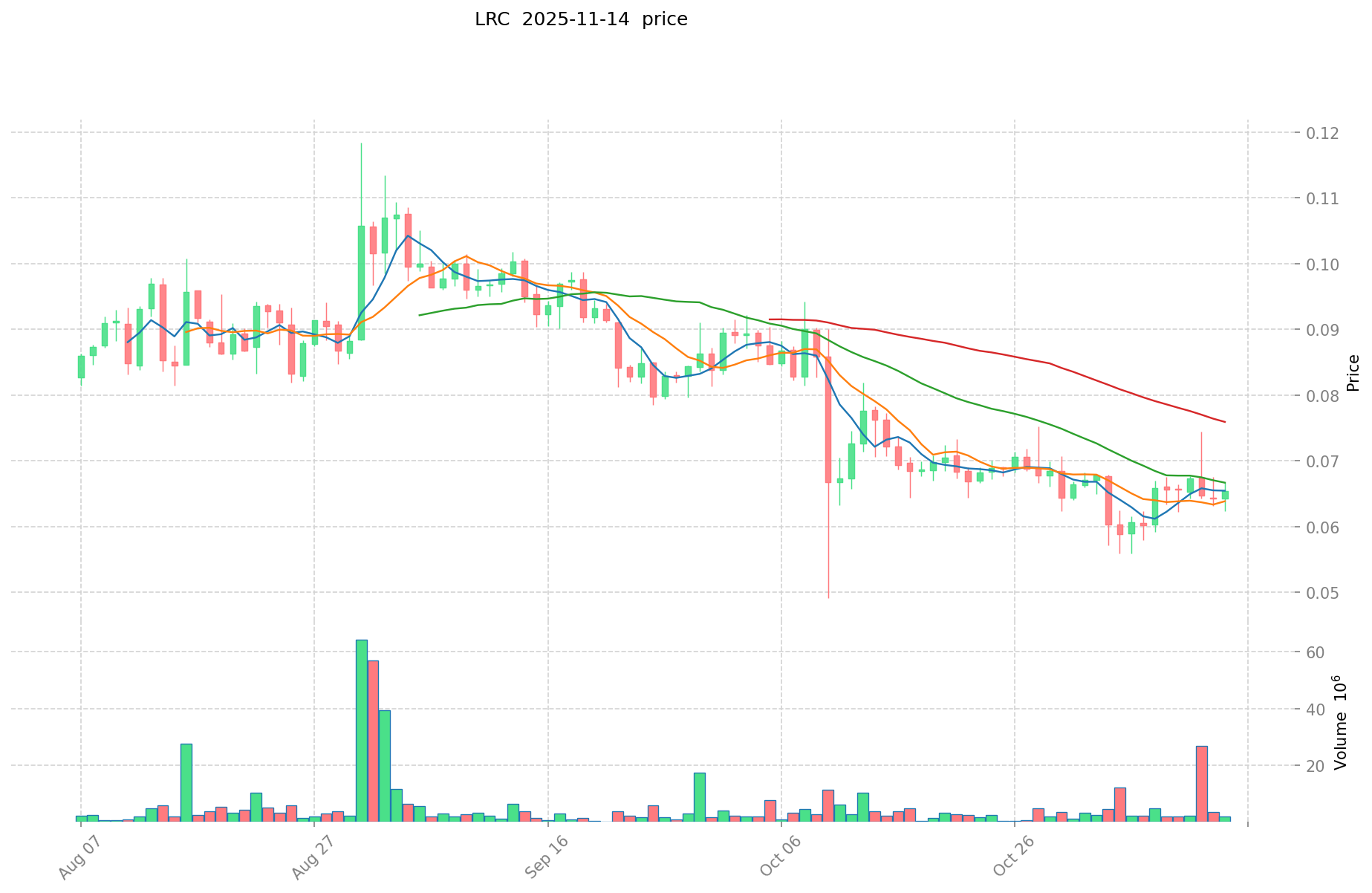NEAR vs LRC: Comparing Two Promising Blockchain Protocols for Scalability and Efficiency
Introduction: NEAR vs LRC Investment Comparison
In the cryptocurrency market, the comparison between NEAR and LRC has always been a topic that investors cannot ignore. The two not only have significant differences in market cap ranking, application scenarios, and price performance, but also represent different positions in crypto assets.
NEAR (NEAR): Since its launch in 2020, it has gained market recognition for its highly scalable protocol supporting DApp operations on mobile devices.
LRC (LRC): Introduced in 2017, it has been hailed as a decentralized exchange protocol, providing a zero-risk token exchange model on Ethereum.
This article will comprehensively analyze the investment value comparison between NEAR and LRC, focusing on historical price trends, supply mechanisms, institutional adoption, technological ecosystems, and future predictions, attempting to answer the question that investors are most concerned about:
"Which is the better buy right now?"
I. Price History Comparison and Current Market Status
NEAR (Coin A) and LRC (Coin B) Historical Price Trends
- 2022: NEAR reached its all-time high of $20.44 on January 17, 2022.
- 2021: LRC hit its all-time high of $3.75 on November 10, 2021.
- Comparative analysis: During the recent market cycle, NEAR dropped from its high of $20.44 to a current price of $2.42, while LRC fell from $3.75 to $0.06233.
Current Market Situation (2025-11-14)
- NEAR current price: $2.42
- LRC current price: $0.06233
- 24-hour trading volume: NEAR $5,398,410.53 vs LRC $139,727.49
- Market Sentiment Index (Fear & Greed Index): 16 (Extreme Fear)
Click to view real-time prices:
- Check NEAR's current price Market Price
- Check LRC's current price Market Price


II. Core Factors Affecting NEAR vs LRC Investment Value
Supply Mechanisms Comparison (Tokenomics)
- NEAR: Initially inflationary with 5% annual issuance, gradually decreasing to 1.66% through token burning mechanisms. Maximum supply capped at 1 billion tokens.
- LRC: Deflationary model with maximum supply of 1.4 billion tokens. Features token burning mechanism where 10% of protocol fees are used to buy back and burn LRC.
- 📌 Historical Pattern: NEAR's controlled inflation provides predictable supply growth while LRC's deflationary mechanism creates potential scarcity over time, influencing price movements during market cycles.
Institutional Adoption and Market Applications
- Institutional Holdings: NEAR has attracted more institutional interest with backing from Andreessen Horowitz, Coinbase Ventures, and Multicoin Capital. LRC has received less institutional investment but maintains strategic partnerships.
- Enterprise Adoption: NEAR's Aurora ecosystem enables Ethereum compatibility for enterprise applications, while LRC focuses specifically on DEX infrastructure with emphasis on low transaction costs.
- Regulatory Attitudes: Both projects face similar regulatory scrutiny in most jurisdictions, with neither having significant regulatory advantages over the other.
Technical Development and Ecosystem Building
- NEAR Technical Upgrades: Implemented sharding via Nightshade for improved scalability, offering over 100,000 TPS. Fast finality (1-2 seconds) makes it competitive for real-world applications.
- LRC Technical Development: Layer 2 scaling solution focusing on high throughput and low costs on Ethereum. Utilizes zkRollup technology for security while processing up to 2,025 trades per second.
- Ecosystem Comparison: NEAR has broader ecosystem spanning DeFi, NFTs, gaming and Web3 applications. LRC is more focused on DEX infrastructure and payment solutions within the Ethereum ecosystem.
Macroeconomic Factors and Market Cycles
- Performance During Inflation: NEAR's larger market cap and greater institutional backing may provide better stability during inflation, while LRC's specialized use case makes it more sensitive to DeFi market conditions.
- Monetary Policy Effects: Both tokens show sensitivity to Federal Reserve policies, with tightening cycles typically putting pressure on growth-oriented crypto assets.
- Geopolitical Factors: NEAR's cross-chain capabilities potentially position it better for international adoption, while LRC benefits from increased demand for non-custodial trading during periods of economic uncertainty.
III. 2025-2030 Price Prediction: NEAR vs LRC
Short-term Prediction (2025)
- NEAR: Conservative $2.04-$2.43 | Optimistic $2.43-$3.33
- LRC: Conservative $0.057-$0.063 | Optimistic $0.063-$0.080
Mid-term Prediction (2027)
- NEAR may enter a growth phase, with estimated prices of $3.31-$4.70
- LRC may enter a steady growth phase, with estimated prices of $0.075-$0.094
- Key drivers: Institutional fund inflows, ETFs, ecosystem development
Long-term Prediction (2030)
- NEAR: Base scenario $4.65-$5.81 | Optimistic scenario $5.81+
- LRC: Base scenario $0.111-$0.126 | Optimistic scenario $0.126+
Disclaimer: This analysis is based on historical data and market projections. Cryptocurrency markets are highly volatile and unpredictable. This information should not be considered as financial advice. Always conduct your own research before making investment decisions.
NEAR:
| 年份 | 预测最高价 | 预测平均价格 | 预测最低价 | 涨跌幅 |
|---|---|---|---|---|
| 2025 | 3.32773 | 2.429 | 2.04036 | 0 |
| 2026 | 3.7418745 | 2.878365 | 2.61931215 | 19 |
| 2027 | 4.700370045 | 3.31011975 | 3.04531017 | 37 |
| 2028 | 4.56597918315 | 4.0052448975 | 2.843723877225 | 66 |
| 2029 | 5.01416608718025 | 4.285612040325 | 2.27137438137225 | 78 |
| 2030 | 5.812361329690781 | 4.649889063752625 | 4.417394610564993 | 93 |
LRC:
| 年份 | 预测最高价 | 预测平均价格 | 预测最低价 | 涨跌幅 |
|---|---|---|---|---|
| 2025 | 0.0800128 | 0.06251 | 0.0568841 | 0 |
| 2026 | 0.079812768 | 0.0712614 | 0.042044226 | 14 |
| 2027 | 0.09366598416 | 0.075537084 | 0.07251560064 | 21 |
| 2028 | 0.1150580863488 | 0.08460153408 | 0.0744493499904 | 35 |
| 2029 | 0.121792368461568 | 0.0998298102144 | 0.065887674741504 | 60 |
| 2030 | 0.126324641845301 | 0.110811089337984 | 0.070919097176309 | 77 |
IV. Investment Strategy Comparison: NEAR vs LRC
Long-term vs Short-term Investment Strategies
- NEAR: Suitable for investors focused on ecosystem potential and scalability
- LRC: Suitable for investors interested in DEX infrastructure and Ethereum Layer 2 solutions
Risk Management and Asset Allocation
- Conservative investors: NEAR: 60% vs LRC: 40%
- Aggressive investors: NEAR: 70% vs LRC: 30%
- Hedging tools: Stablecoin allocation, options, cross-currency portfolios
V. Potential Risk Comparison
Market Risks
- NEAR: Higher volatility due to larger market cap and broader ecosystem exposure
- LRC: More susceptible to DeFi market fluctuations and Ethereum ecosystem changes
Technical Risks
- NEAR: Scalability challenges, network stability during high traffic
- LRC: Smart contract vulnerabilities, reliance on Ethereum network upgrades
Regulatory Risks
- Global regulatory policies may impact both, with NEAR potentially facing more scrutiny due to its broader ecosystem
VI. Conclusion: Which Is the Better Buy?
📌 Investment Value Summary:
- NEAR advantages: Broader ecosystem, institutional backing, scalability potential
- LRC advantages: Specialized DEX infrastructure, deflationary tokenomics, Ethereum Layer 2 solution
✅ Investment Advice:
- New investors: Consider a higher allocation to NEAR due to its broader market exposure
- Experienced investors: Balanced portfolio with both NEAR and LRC, leveraging their respective strengths
- Institutional investors: Focus on NEAR for its scalability and ecosystem growth potential
⚠️ Risk Warning: Cryptocurrency markets are highly volatile. This article does not constitute investment advice. None
VII. FAQ
Q1: What are the main differences between NEAR and LRC? A: NEAR is a highly scalable protocol supporting DApp operations on mobile devices, while LRC is a decentralized exchange protocol on Ethereum. NEAR has a broader ecosystem spanning DeFi, NFTs, gaming, and Web3 applications, while LRC focuses specifically on DEX infrastructure.
Q2: Which token has performed better historically? A: NEAR reached its all-time high of $20.44 in January 2022, while LRC hit its all-time high of $3.75 in November 2021. Both have since declined, with NEAR currently at $2.42 and LRC at $0.06233.
Q3: How do the supply mechanisms of NEAR and LRC differ? A: NEAR has an initially inflationary model with a 5% annual issuance, gradually decreasing to 1.66% through token burning. LRC has a deflationary model with a maximum supply of 1.4 billion tokens and features a token burning mechanism.
Q4: Which token has more institutional adoption? A: NEAR has attracted more institutional interest, with backing from Andreessen Horowitz, Coinbase Ventures, and Multicoin Capital. LRC has received less institutional investment but maintains strategic partnerships.
Q5: What are the key technical features of each token? A: NEAR implemented sharding via Nightshade for improved scalability, offering over 100,000 TPS. LRC utilizes zkRollup technology for security while processing up to 2,025 trades per second on Ethereum.
Q6: What are the long-term price predictions for NEAR and LRC? A: By 2030, NEAR is predicted to reach $4.65-$5.81 in the base scenario, while LRC is expected to reach $0.111-$0.126. These predictions are subject to market conditions and should not be considered financial advice.
Q7: How should investors allocate their portfolio between NEAR and LRC? A: Conservative investors might consider a 60% NEAR to 40% LRC allocation, while aggressive investors might opt for 70% NEAR to 30% LRC. However, individual allocation should be based on personal risk tolerance and investment goals.
Share
Content